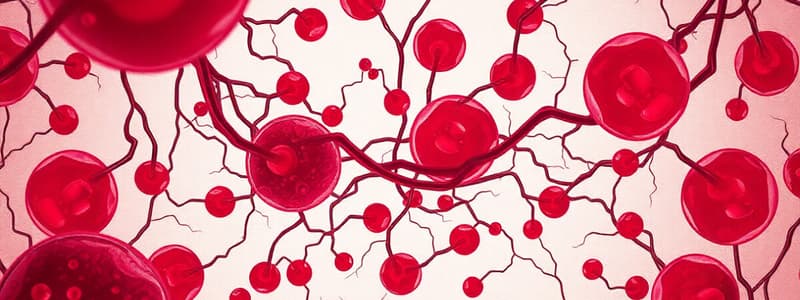Podcast
Questions and Answers
What is one of the primary functions of blood in the human body?
What is one of the primary functions of blood in the human body?
Which phase of hemostasis involves the narrowing of blood vessels at the injury site?
Which phase of hemostasis involves the narrowing of blood vessels at the injury site?
What characterizes hemophilia as a blood disorder?
What characterizes hemophilia as a blood disorder?
What is one of the important roles of blood concerning the body's temperature?
What is one of the important roles of blood concerning the body's temperature?
Signup and view all the answers
Which waste product is transported by blood for excretion?
Which waste product is transported by blood for excretion?
Signup and view all the answers
What is the primary component of blood plasma?
What is the primary component of blood plasma?
Signup and view all the answers
Which type of blood cell is responsible for carrying oxygen in the body?
Which type of blood cell is responsible for carrying oxygen in the body?
Signup and view all the answers
Which type of leukocyte is involved in phagocytosis and acts as a first responder to infection?
Which type of leukocyte is involved in phagocytosis and acts as a first responder to infection?
Signup and view all the answers
What is the function of thrombocytes in the blood?
What is the function of thrombocytes in the blood?
Signup and view all the answers
What happens to erythrocytes after their lifespan of about 120 days?
What happens to erythrocytes after their lifespan of about 120 days?
Signup and view all the answers
Which blood cell type transforms into macrophages to engulf foreign materials?
Which blood cell type transforms into macrophages to engulf foreign materials?
Signup and view all the answers
What determines an individual's blood type?
What determines an individual's blood type?
Signup and view all the answers
Which component of blood constitutes approximately 55% of blood volume?
Which component of blood constitutes approximately 55% of blood volume?
Signup and view all the answers
Study Notes
Blood Composition
- Blood is a connective tissue consisting of various components:
- Plasma: The liquid portion (approximately 55% of blood volume), composed primarily of water, proteins (albumin, globulins, fibrinogen), electrolytes, nutrients, hormones, and waste products.
- Formed elements: Cells and cell fragments suspended in plasma. These include:
- Erythrocytes (red blood cells): Carry oxygen throughout the body.
- Leukocytes (white blood cells): Crucial for the immune system, defending against infection and disease. Different types include neutrophils, lymphocytes, monocytes, eosinophils, and basophils.
- Thrombocytes (platelets): Involved in blood clotting.
Erythrocytes (Red Blood Cells)
- Biconcave disc shape, optimized for gas exchange.
- Contain hemoglobin, an iron-rich protein that binds to and transports oxygen.
- Lack a nucleus and organelles to maximize space for hemoglobin.
- Lifespan of about 120 days.
- Produced in red bone marrow.
- Removed from circulation by macrophages in the liver and spleen.
Leukocytes (White Blood Cells)
- Crucial part of the immune system.
- Classified into granular (with granules in their cytoplasm) and agranular (without granules).
- Granulocytes: Neutrophils, eosinophils, basophils.
- Agranulocytes: Lymphocytes and monocytes.
- Defend the body against pathogens, foreign substances, and abnormal cells.
- Various types perform different functions:
- Neutrophils: Phagocytic, first responders to infection.
- Lymphocytes: Produce antibodies, regulate immune response; types include B cells, T cells, and natural killer (NK) cells.
- Monocytes: Transform into macrophages, engulf foreign materials and pathogens.
- Eosinophils: Involved in allergic reactions and parasitic infections.
- Basophils: Release histamine and heparin, contributing to inflammation.
Thrombocytes (Platelets)
- Fragments of megakaryocytes (large cells in bone marrow).
- Essential for blood clotting (hemostasis)
- Initiate the formation of a platelet plug to stop bleeding.
- Release clotting factors and other substances important in the coagulation cascade.
Blood Types
- Blood types are determined by the presence or absence of specific antigens on the surface of red blood cells.
- The ABO system and Rh factor are the most significant.
- Mismatched blood transfusions can lead to potentially fatal reactions.
- Understanding blood types is crucial for safe blood transfusions.
Blood Plasma
- The liquid component of blood.
- Contains water, proteins, electrolytes, nutrients, hormones, and waste products.
- Maintains blood volume and pressure.
- Key role in transporting various substances throughout the body.
- Important for maintaining blood pH.
Blood Function
- Transport of gases (oxygen and carbon dioxide).
- Transport of nutrients (glucose, amino acids, lipids).
- Transport of waste products (urea, creatinine).
- Transport of hormones.
- Regulation of body temperature.
- Defense against infection.
- Clotting to prevent blood loss.
- Maintenance of acid-base balance.
Hemostasis (Blood Clotting)
- A complex process to stop bleeding, preventing blood loss.
- Includes three major phases:
- Vascular spasm: Narrowing of blood vessels at the site of injury
- Platelet plug formation: Platelets adhere to exposed collagen and form a temporary plug
- Coagulation (blood clotting): Formation of a fibrin mesh that traps red blood cells and platelets, forming a stable clot.
- Essential for tissue repair.
Blood Disorders
- Various conditions can affect blood cells and components.
- Examples include anemia (low red blood cell count or hemoglobin deficiency), leukemia (cancer of white blood cells), hemophilia (clotting disorder), and thrombocytopenia (low platelet count).
- Prompt diagnosis is vital for proper treatment and patient management.
Studying That Suits You
Use AI to generate personalized quizzes and flashcards to suit your learning preferences.
Description
Explore the essential components of blood, including plasma and formed elements like erythrocytes, leukocytes, and thrombocytes. This quiz covers their structure, function, and the role they play in the human body.




